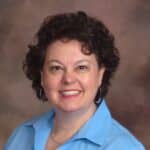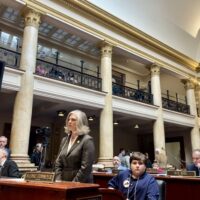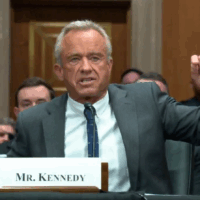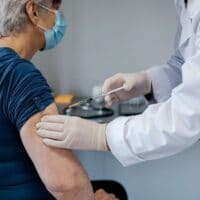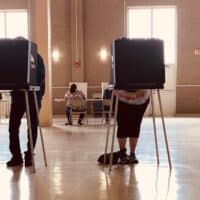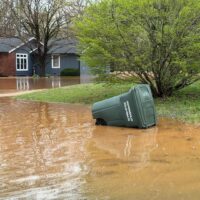As decisions about whether to require masks to thwart the coronavirus in Kentucky move to local school districts, governments and businesses, there’s still much doubt and misinformation about whether they actually work to slow the spread of the virus, even though research shows they do.

One Kentuckian who isn’t convinced is Janel Carter of Boston, Ky., who held a “Stop the Mandates” sign outside the Capitol on Sept. 7, the first day of the special legislative session that ended statewide mandates. Carter told Kentucky Health News that she doesn’t like any of the mandates. “It’s just choking us, the injections, the masks, the staying in,” she said, adding, “I’m not seeing where it does” any good.
Asked if she wanted evidence that it does, she said, “I do,” and indicated that she’s seen some, but not enough. “I would like full strength. I feel like we’re at 20%. I used to work at Frazier Rehab in downtown Louisville.” (Rehabilitation facilities measure patients’ capacity in percentages.)
Before the special session began, Democratic Gov. Andy Beshear sent the overwhelmingly Republican legislature links to 49 studies, analyses, polls and other publications on masking, mask mandates and school prevention efforts.
The largest randomized controlled study of masks, led by researchers from Stanford and Yale universities, looked at the benefits of surgical mask use by more than 342,000 adults in Bangladesh. It found that mask usage increased 29% in the intervention group where masks were promoted, and the group showed an 11% reduction in COVID-19 infections, with a 35% reduction among those over 60. The Washington Post reports that the study is under peer review with the journal Science.
This study is the latest that clearly supports the value of wearing surgical masks for reducing infection. Cloth masks can also work, according to one of the earliest studies published by the Centers for Disease Control and Prevention.
It looked at a Springfield, Mo., hair salon where two stylists with symptomatic Coivd-19 interacted for an average of 15 minutes with each of 139 clients over an eight-day period before either stylist was diagnosed. None of the 67 clients who consented to interviews and testing developed an infection. Both stylists wore double-layered cloth masks; one sometimes wore a surgical mask. Among the clients, almost half each wore cloth or surgical masks, and a few wore N-95 masks.
Most people wear cloth masks, and often don’t wear them properly.
In a story titled “How well do face masks protect against the coronavirus?” the Mayo Clinic advises how to choose the best cloth mask, saying, “The most effective cloths masks are made of multiple layers of tightly-woven fabric like cotton. A mask with layers will stop more droplets from getting through your mask or escaping from it.”
Further, the clinic recommends that masks fit snugly over the nose, mouth and chin, and that be “well fitted to the contours of your face to prevent leakage of air from around the masks’ edges.”
A review of data from 10 studies published in the Journal of the American Medical Association concluded that mask-wearing substantially reduces the spread of the virus. The researchers reported that “multilayer cloth masks were more effective than single-layer masks, blocking as much as 50% to 70% of exhaled small droplets and particles.” The researchers also point to a COVID-19 outbreak on the USS Theodore Roosevelt, where persons who wore masks experienced a 70% lower risk of testing positive for the disease. The researchers provide a table that reviews the study findings.
Another study involved a high-speed laser-light video experiment, which caused oral fluid droplets to appear as flashes in the light. “When observed, between 227 and 347 oral fluid droplets flashed when participants said the words “stay healthy” without a mask. When the same phrase was spoken with a mask, “the flash count remained close to background level.” The study was published in The New England Journal of Medicine, and cited in a report by KXAN of Austin, Texas, with 48 other scientific studies explaining how masks can slow the spread of the virus.
Slow, not stop. Another CDC-published study found that a COVID-19 outbreak in California was traced to an unvaccinated, mildly symptomatic teacher who reportedly read to her 24 masked, unvaccinated students while unmasked, infecting half of them. Parents and students said social distancing and masking adherence among the students was high. The closer students sat to the teacher, the more likely they were to be infected.
The CDC guidance on universal masking in schools says: “Because of the highly transmissible nature of [the Delta] variant, along with the extent of mixing of vaccinated and unvaccinated people in schools, the fact that children under 12 years of age are not currently eligible for vaccination, and low levels of vaccination among youth ages 12-17, CDC recommends universal indoor masking for all students (age 2 years and older), teachers, staff, and visitors to K-12 schools regardless of vaccination status.”
The American Academy of Pediatrics recommends that “all eligible individuals receive the COVID-19 vaccine” and that “all students older than 2 years and all school staff should wear face masks at school (unless medical or developmental conditions prohibit use).”
It is also important to remember that masking is meant to be part of a “layered prevention” strategy to protect against the coronavirus that also includes vaccinations, social distancing, hand hygiene, testing, and a need for people to stay home when sick.
Melissa Patrick is a reporter for Kentucky Health News, an independent news service of the Institute for Rural Journalism and Community Issues, based in the School of Journalism and Media at the University of Kentucky, with support from the Foundation for a Healthy Kentucky. She has received several competitive fellowships, including the 2016-17 Nursing and Health Care Workforce Media Fellow of the Center for Health, Media & Policy, which allowed her to focus on and write about nursing workforce issues in Kentucky; and the year-long Association of Health Care Journalists 2017-18 Regional Health Journalism Program fellowship. She is a former registered nurse and holds degrees in journalism and community leadership and development from UK.
